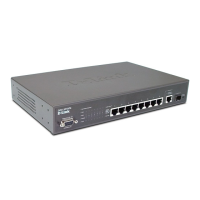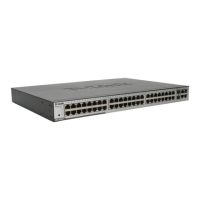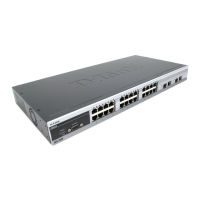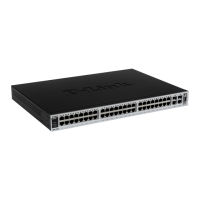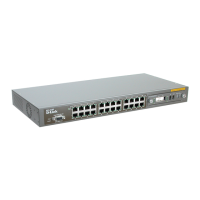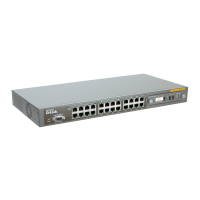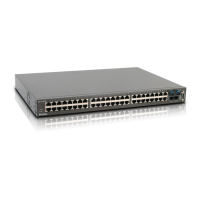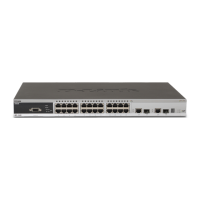Do you have a question about the D-Link DES-3010GA and is the answer not in the manual?
Describes different command modes and their hierarchy within the CLI.
Details privileged mode access, its prompt, and command restrictions.
Describes commands for configuring the system on a global level.
Lists modes for configuring specific interface operations like Line, VLAN, and Ethernet.
Outlines steps to connect to the device and begin CLI usage.
Defines login authentication methods for CLI access.
Configures authentication methods for privilege level access.
Adds a MAC-layer station source address to the bridge table.
Locks the port to block unknown traffic and prevent learning.
Manually sets the system clock time and date.
Copies files from a source to a destination.
Enters interface configuration mode to configure an Ethernet interface.
Configures multiple Ethernet interfaces simultaneously.
Configures the full/half duplex operation of an Ethernet interface.
Enables auto-negotiation for speed and duplex parameters.
Configures flow control on a given interface.
Enables cable crossover on a given interface.
Enables back pressure on a given interface.
Enables broadcast storm control.
Configures the maximum broadcast rate.
Enables GARP VLAN Registration Protocol globally.
Enables GVRP on a specific interface.
Enables Internet Group Management Protocol (IGMP) snooping globally.
Enables IGMP snooping on a specific VLAN interface.
Sets an IP address on an interface.
Acquires an IP address for an interface from a DHCP server.
Defines a default gateway (router).
Configures the system priority for LACP.
Configures physical port priority for LACP.
Assigns an administrative LACP timeout.
Identifies a specific line for configuration.
Sets the line baud rate.
Configures a management access list.
Restricts management connections by defining the active access list.
Diagnoses copper cable quality using Time Domain Reflectometry.
Enters interface configuration mode to configure a specific port-channel.
Configures multiple port-channels simultaneously.
Associates a port with a port-channel.
Starts a port monitoring session.
Enables Quality of Service (QoS) on the device.
Limits the rate of incoming traffic on an interface.
Configures the system's trust state for QoS.
Enables port trust state for QoS.
Specifies a RADIUS server host.
Sets the authentication and encryption key for RADIUS.
Displays RMON Ethernet statistics.
Configures alarm conditions for RMON.
Configures community access strings for SNMP protocol.
Creates or updates an SNMP server view entry.
Configures an SNMP group or maps users to views.
Configures a new SNMP Version 3 user.
Specifies the SNMP engineID on the local device.
Specifies the recipient of SNMP Version 1 or Version 2 notifications.
Specifies the recipient of SNMP Version 3 notifications.
Enables spanning-tree functionality.
Configures the spanning-tree protocol (STP, RSTP, MSTP).
Configures the spanning-tree bridge forward time.
Configures the spanning tree bridge hello time.
Configures the spanning tree bridge maximum age.
Configures the spanning tree priority of the device.
Configures the spanning tree path cost for a port.
Configures port priority for spanning tree.
Enables PortFast mode for faster forwarding.
Overrides default link-type setting for RSTP transitions.
Sets the default path cost method for spanning tree.
Enables root guard on spanning tree instances.
Configures device priority for a specified spanning-tree instance.
Configures port priority for the specified MST instance.
Configures the path cost for multiple spanning tree calculations.
Enables configuring an MST region.
Maps VLANs to an MST instance.
Controls error message logging.
Logs messages to a syslog server.
Sends ICMP echo request packets to another node.
Discovers routes that packets take to their destination.
Specifies or modifies the device host name.
Enters the Privileged EXEC mode.
Enters the Global Configuration mode.
Enters the VLAN Configuration mode.
Creates a VLAN.
Enters the Interface Configuration (VLAN) mode.
Configures multiple VLANs simultaneously.
Configures the primary PVLAN.
Configures the isolated VLAN of the PVLAN.
Associates the primary VLAN with community VLANs.
Configures the VLAN membership mode of a port.
Configures the VLAN ID when the interface is in access mode.
Configures private-vlan port VLANs.
Adds or removes VLANs to or from a trunk port.
Describes different command modes and their hierarchy within the CLI.
Details privileged mode access, its prompt, and command restrictions.
Describes commands for configuring the system on a global level.
Lists modes for configuring specific interface operations like Line, VLAN, and Ethernet.
Outlines steps to connect to the device and begin CLI usage.
Defines login authentication methods for CLI access.
Configures authentication methods for privilege level access.
Adds a MAC-layer station source address to the bridge table.
Locks the port to block unknown traffic and prevent learning.
Manually sets the system clock time and date.
Copies files from a source to a destination.
Enters interface configuration mode to configure an Ethernet interface.
Configures multiple Ethernet interfaces simultaneously.
Configures the full/half duplex operation of an Ethernet interface.
Enables auto-negotiation for speed and duplex parameters.
Configures flow control on a given interface.
Enables cable crossover on a given interface.
Enables back pressure on a given interface.
Enables broadcast storm control.
Configures the maximum broadcast rate.
Enables GARP VLAN Registration Protocol globally.
Enables GVRP on a specific interface.
Enables Internet Group Management Protocol (IGMP) snooping globally.
Enables IGMP snooping on a specific VLAN interface.
Sets an IP address on an interface.
Acquires an IP address for an interface from a DHCP server.
Defines a default gateway (router).
Configures the system priority for LACP.
Configures physical port priority for LACP.
Assigns an administrative LACP timeout.
Identifies a specific line for configuration.
Sets the line baud rate.
Configures a management access list.
Restricts management connections by defining the active access list.
Diagnoses copper cable quality using Time Domain Reflectometry.
Enters interface configuration mode to configure a specific port-channel.
Configures multiple port-channels simultaneously.
Associates a port with a port-channel.
Starts a port monitoring session.
Enables Quality of Service (QoS) on the device.
Limits the rate of incoming traffic on an interface.
Configures the system's trust state for QoS.
Enables port trust state for QoS.
Specifies a RADIUS server host.
Sets the authentication and encryption key for RADIUS.
Displays RMON Ethernet statistics.
Configures alarm conditions for RMON.
Configures community access strings for SNMP protocol.
Creates or updates an SNMP server view entry.
Configures an SNMP group or maps users to views.
Configures a new SNMP Version 3 user.
Specifies the SNMP engineID on the local device.
Specifies the recipient of SNMP Version 1 or Version 2 notifications.
Specifies the recipient of SNMP Version 3 notifications.
Enables spanning-tree functionality.
Configures the spanning-tree protocol (STP, RSTP, MSTP).
Configures the spanning-tree bridge forward time.
Configures the spanning tree bridge hello time.
Configures the spanning tree bridge maximum age.
Configures the spanning tree priority of the device.
Configures the spanning tree path cost for a port.
Configures port priority for spanning tree.
Enables PortFast mode for faster forwarding.
Overrides default link-type setting for RSTP transitions.
Sets the default path cost method for spanning tree.
Enables root guard on spanning tree instances.
Configures device priority for a specified spanning-tree instance.
Configures port priority for the specified MST instance.
Configures the path cost for multiple spanning tree calculations.
Enables configuring an MST region.
Maps VLANs to an MST instance.
Controls error message logging.
Logs messages to a syslog server.
Sends ICMP echo request packets to another node.
Discovers routes that packets take to their destination.
Specifies or modifies the device host name.
Enters the Privileged EXEC mode.
Enters the Global Configuration mode.
Enters the VLAN Configuration mode.
Creates a VLAN.
Enters the Interface Configuration (VLAN) mode.
Configures multiple VLANs simultaneously.
Configures the primary PVLAN.
Configures the isolated VLAN of the PVLAN.
Associates the primary VLAN with community VLANs.
Configures the VLAN membership mode of a port.
Configures the VLAN ID when the interface is in access mode.
Configures private-vlan port VLANs.
Adds or removes VLANs to or from a trunk port.
| Type | Managed |
|---|---|
| Layer | Layer 2 |
| Switching Capacity | 20 Gbps |
| MAC Address Table | 8K |
| Power Supply | Internal |
| RAM | 128 MB |
| Flash Memory | 16 MB |
| Jumbo Frame Support | Yes |
| VLAN Support | Yes |
| Humidity | 10% to 90% non-condensing |
| Ports | 8 x 10/100/1000Base-T |
| Jumbo Frame Size | 9KB |
| Operating Temperature | 0°C to 40°C |
